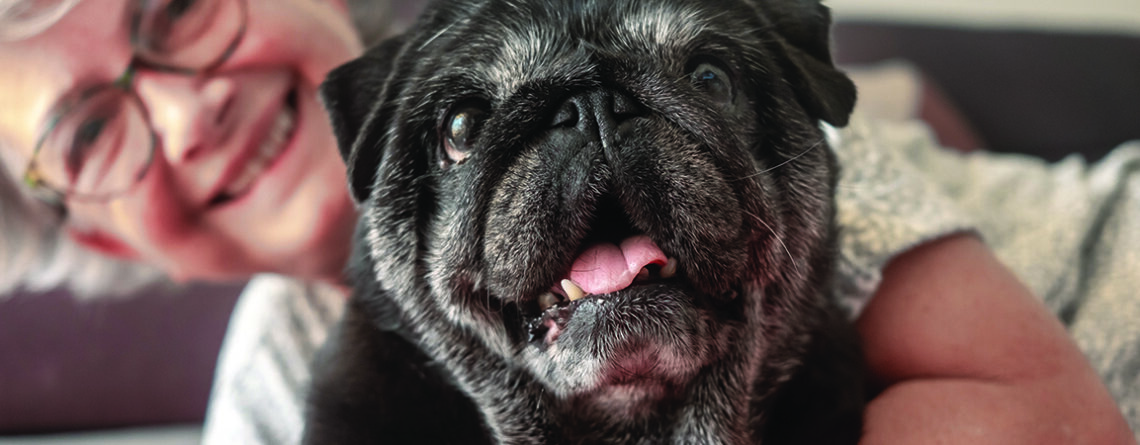10 Tips on Handling Your Senior Dog Safely
Aging is a normal part of life, and at some point, all dogs will get older and become seniors. As our dogs grow into this life stage, their care requirements will begin to change, such as their diet and exercise routine. You may find your older dog is walking at a slower pace or is finding it difficult to leap onto the sofa like he once could. All these changes are completely normal, but it’s important to know how to adapt to them to ensure your dog is happy and healthy.
Here, we give our top ten tips on handling your senior dog safely, what to consider when helping him move around, and to make his golden years as comfortable as they can be.
Grooming
- Always make sure to check your brushes and combs to determine that they are in good condition and not damaged. Broken or bent brush teeth can scratch the skin or cause coat breakage. If you’re uncertain to what type of brush or comb your dog needs, contact your local Petmania Grooming Studio and one of our Professional Groomers will be more than happy to assist you.
- Watch for signs of discomfort or pain when grooming your senior dog. Older dogs may not be able to stand as long they once could, so make sure to very slowly and carefully adjust to a more comfortable position. Don’t keep him in the grooming seat too long; it is more ideal to work on your dog for 10 minutes at a time, a few days a week than to expect him to endure longer grooming sessions.
- If you notice them slipping and sliding in the bath or on the table when you’re grooming them, consider using a non-slip mat that will secure their footing. This will especially help them if they have arthritis or mobility issues.
- Conduct a full body inspection when grooming your dog. Check his ears, eyes, mouth, sanitary area and his nails. Older dogs will also need their nails trimmed more often, so make you are staying on top of this; healthy nail lengths are important for dogs who have arthritis or joint problems.

At Home Care
- Senior doggies need a good bed as muscle and joint problems are rife when they age. A pain-free, restful sleep is very important for older dogs. It can improve mobility, lessen pain, and improve their quality of life. A thermal dog bed can assist a senior dog with problems regarding stiffness and joints. Dogs who suffer with conditions like arthritis, hip dysplasia, and other joint or circulation problems will also benefit from an orthopaedic or memory foam bed which they can get in and out of easily, like the M-PETS Oleron Memory Foam Mattress,which provides your dog with extra support and comfort. Alternatively, you can also place a blanket or mat into your dog’s bed for a similar effect.
- Little changes like using a dog ramp to help your pup get up and down from the car or an elevated dog bowl to eliminate excess strain on a dog’s head and neck. Always keep an eye out for any signs of discomfort such as limping, difficulty changing position, trouble getting up the stairs or jumping, and lying down when eating or drinking—all of which suggest that your dog will need to take a visit to the vet.

Healthcare
- Periodontal disease is very common in older dogs and if ignored, it can become very serious, so regular mouth and teeth inspections are important. Brush his teeth regularly with a dog-friendly toothbrush and toothpaste.
- Walking is the best activity for any dog, and taking your older dog out on walks is a great way for him to keep fit and mobile. Take them on a shorter route and be sure to stop for plenty of rests. Sometimes, two short, separate 10 minute walks in the day is better than one, long, 20 minute walk.
- Vet Carol Doyle recommends moving to a senior dog food formula as your dog reaches his golden years. “These will have been developed with lower calorie levels and a careful balance of other nutrients, such as essential fatty acids and antioxidants to support your dog’s ageing joints and immune system,” she says. She added, “Your dog will probably be used to being fed twice a day, although as they reach their senior years, they may prefer smaller portions more often. Always follow the recommended feeding guide for the brand you are choosing to feed, and use a digital scales to measure portion size for your dog.”
- Always keep a eye out for any parasites that may have found their way into your dog’s coat. Watch out for obsessive itching, chewing around the tail or hind legs, lethargy and patchy hair loss. To ensure your senior pup doesn’t get an infestation of fleas, ticks, or other nasty bugs, take preventative care by treating your dog with a spot-on treatment, like Fleatix, and regular visits to the vet.

